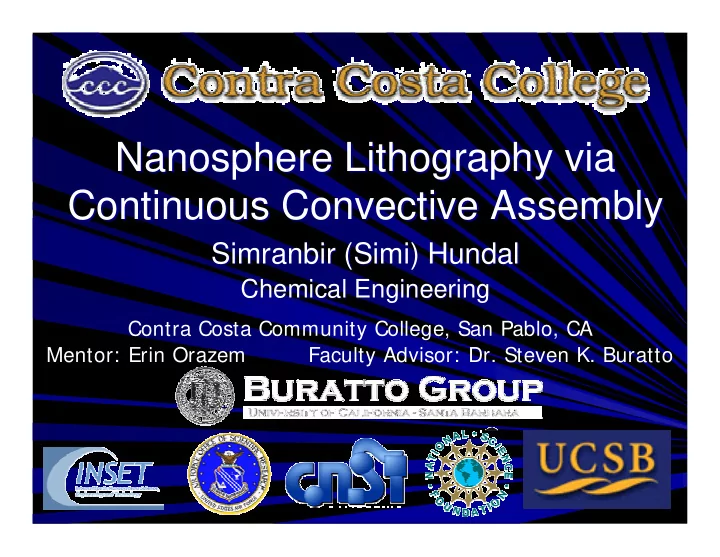

Nanosphere Lithography via Nanosphere Lithography via Continuous Convective Assembly Continuous Convective Assembly Simranbir (Simi) Hundal Simranbir (Simi) Hundal Chemical Engineering Chemical Engineering Contra Costa Community College, San Pablo, CA Mentor: Erin Orazem Faculty Advisor: Dr. Steven K. Buratto
The “Big Picture” The “Big Picture” Using nanosphere nanosphere lithography to produce the lithography to produce the Using largest possible coverage of silver triangles largest possible coverage of silver triangles Considered variables: cleaning solutions, Considered variables: cleaning solutions, nanosphere solution concentration, slide type, nanosphere solution concentration, slide type, sphere size, and withdrawal rate sphere size, and withdrawal rate
Methods Methods Continuous Convective Assembly (CCA) Continuous Convective Assembly (CCA) To create monolayer arrays of hexagonal closed packed To create monolayer arrays of hexagonal closed packed nanospheres nanospheres 2.5 µ m Nanosphere Lithography (NSL) Nanosphere Lithography (NSL) Monolayers of nanospheres used as “masks” when Monolayers of nanospheres used as “masks” when evaporating with silver to generate ordered arrays of evaporating with silver to generate ordered arrays of triangles. triangles. 1 µ m
Continuous Convective Assembly using Continuous Convective Assembly using the Stepper Motor (Dippy) the Stepper Motor (Dippy) Convective Assembly of the nanospheres on the slide Convective Assembly of the nanospheres on the slide Slide is withdrawn out of the solution at a particular Slide is withdrawn out of the solution at a particular µ m/min; fast: 180 µ m/min) rate (slow: ~60 µ m/min; fast: 180 µ m/min) rate (slow: ~60 Glass Slide Height Nanospheres 2.5 µ m Nanosphere Solution
Nanosphere Lithography Used to generate ordered arrays of triangles by using the monolayers of nanospheres as a “mask” for the evaporation of silver. Ag Power Supply
Cleaning Solution: Piranha/RCA vs. Chromic/Sulfuric Acid Bath 900nm spheres 5 µ m 5 µ m Piranha/RCA Chromic/Sulfuric Acid Bath Piranha: Concentrated Sulfuric Acid and 30% Hydrogen Peroxide Chromium Trioxide in concentrated Sulfuric Acid RCA: Nanopure water, Ammonium hydroxide, and 30% Hydrogen Peroxide
Glass vs. Mica 900nm spheres 5 µ m 5 µ m Glass Mica In consideration of the variables, the slide type did not have a major affect of the formation of hexagonal close packing.
Withdrawal Rate 400nm spheres Fast rate: ~180 µ m/min Slow rate: ~60 µ m/min 5 µ m 5 µ m At the fast rate there was much more of a closed packed surface
Future Plans Optimizing evaporation conditions Optimizing variables: volume concentration, sphere size Optimizing for smaller sphere diameters, i.e. 20nm
Applications The triangular arrays are used as substrates for surface-enhanced Raman spectroscopy (SERS). Prepare optical units, electronic Read Only Memory (ROM) devices Fabrication of periodic particle array (PPA) surfaces. Chemical and biological sensors
So What Did I Learn? Instruments Atomic Force Microscope (AFM): Operation and theory Stepper Motor: Operation and using Lab View program Thermal Evaporator: Operation Research Basics of Nanosphere Lithography and characterization using different instruments 8 weeks is not enough for research
Acknowledgements UCSB, Department of Chemistry & Biochemistry Mentor: Erin Orazem Faculty Advisor: Dr. Steven K. Buratto Everyone in INSET Materials Microscopy Lab McFarland Group/Alan Kleiman Buratto Group: James O’Dea and Asanga Ranasinghe Israelachvili Group: Kenny Rosenburg & Intern: Kim-Lien Dinh Martin Vandenbroek: Engineering I Teaching Clean Room
Atomic Force Microscope (AFM) Tapping Mode
Determining the height of the Triangle b= 3/2( √ 3-1-(1/ √ 3))D = 0.232D b= D*0.232 b • 900nm � b~ 209nm • 400nm � b~ 93nm
Glass Slide Height Nanospheres 1 µ m 2.5 µ m Nanosphere Soluti 2.5 µ m 2.5 µ m 2.5 µ m 5 µ m 5 µ m • Pranha/RCA
5 µ m Power Supply
Recommend
More recommend